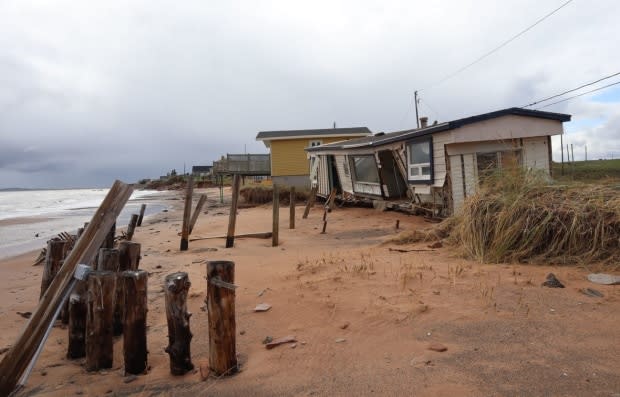Quebec investing $7M to prevent soil erosion on Magdalen Islands
Two successive storms in 2018 and 2019 turned the emergency of the Magdalen Islands' disappearing shoreline into an even more dire situation.
Cottages and roads were unmoored and dropped into the sea as heavy winds and waves ate at the red sandstone.
"Everything was ravaged," recounted island resident Alfred Arseneau last September, after watching one of his rental cottages get blown like a sailboat for more than 100 metres during Hurricane Dorian.
In November 2018, a heavy windstorm struck, knocking down power lines and damaging underwater fibre-optic cables.
As this year's hurricane season approaches, the Quebec government is pledging $7 million by 2022 to help build a structure in Cap-aux-Meules, one of the islands' hardest hit areas, to protect its cliffs.
Deputy Premier Geneviève Guilbault made the announcement in Cap-aux-Meules on Grindstone Island Friday morning.
The funding comes in addition to the $4 million announced in 2018 to protect the historic La Grave site in Havre-Aubert.
Guilbault said the funding for a Cap-aux-Meules project is a long-term solution for one part of a more widespread, persistent problem.
Erosion has always been a fact of life for the nearly 13,000 residents of the Magdalen Islands, a part of Quebec which sits about 150 kilometres northeast of Prince Edward Island.
But researchers say erosion plaguing the islands' banks has seriously accelerated in the last decade because of climate change, with stronger and more frequent storms battering the shoreline.

According to studies by Université du Québec à Rimouski, the average shoreline erosion on the Magdalen Islands has doubled since 2005 to about 46 centimetres — or almost half a metre — per year.
Cap-aux-Meules, where Guilbault spoke Friday, is one of six sites deemed a priority by the Commission permanente sur l'érosion des berges, a group of officials, citizens and environmentalists dedicated to shoreline protection on the Islands.
A new method to protect against erosion
MNA Joël Arseneau said the funding for the Cap-aux-Meules project is welcome, despite there being a long list of other needs.
"All the buildings over a stretch of about 600 metres are at risk within the next two or three years, so knowing it takes some time to take place, we hope that before 2022, this sector will be entirely protected for at least a couple decades," he said.
Arseneau said the funding from the province will go toward a new method: using small rocks to build a sort of beach to protect the cliffs.
"We think this kind of investment will pay off in the future, because I think now we have developed a solution that should be effective, at last," he said.

Arseneau said fighting erosion is always just buying time, but he hopes the Cap-aux-Meules project will protect the cliffs for a few decades.
"This is a first project of what we hope will be many more, because we have at least four or five sites that we will need help from the government to protect," he said.
Islands officials had asked for $80 million
The $7 million Guilbault announced is significantly less than Magdalen Island officials called on the government to invest earlier this year.
In February, Arseneau and Magdalen Islands Mayor Jonathan Lapierre said the government should earmark $80 million in its spring budget to help protect the banks of the archipelago.
The officials issued a joint memo to Quebec Finance Minister Éric Girard, asking that he allot $8 million annually over the next decade to help protect the Magdalen Islands coastline, specifically areas that may not fit government subsidy criteria.
"There needs to be action that is planned and purposeful, and with a substantial budget," Arseneau said at the time. "With 2020 being the year of the environment for the CAQ, I believe the government should intervene."


